How to recognize your generation. Genealogical search for ancestors. Historical restoration of genealogy.
Many people, unfortunately, are absolutely indifferent to the history of their family and ancestors, these are the majority. But there are those who are interested in the history of the family; they learn the history of their forefathers from a young age; unfortunately, they are a minority. According to statistics, only 20% of people are interested in the history of their own family, and they try bit by bit to collect their personal genealogy.
Looking back at the historical facts of past years, many people either lost all contact with their loved ones and the past, or deliberately said goodbye to it. Some families specifically changed their surnames to protect themselves from execution and repression. Today, belonging to a noble family has changed significantly. Availability family relationship to a historically important family name is considered prestigious. Considering the facts, special services have appeared on the Internet services market, where for a certain fee it becomes possible to restore family tree families. To confirm the official status, a special certificate is issued, which lists in detail all family members, with their last name and occupation. By owning this document, it became possible to legally prove one’s belonging to a noble family and enjoy the corresponding benefits.
IN  In our time of the Internet and information technology, just enter the query “how to find out your ancestry” into a search engine and it will immediately appear a large number of links to various sites. Unfortunately, this method does not provide a 100% guarantee that they will find your family members, and not the history of namesakes. There remains one long but reliable option - to search on your own.
In our time of the Internet and information technology, just enter the query “how to find out your ancestry” into a search engine and it will immediately appear a large number of links to various sites. Unfortunately, this method does not provide a 100% guarantee that they will find your family members, and not the history of namesakes. There remains one long but reliable option - to search on your own.
For independent searches you need:
- Survey of relatives
- Data systematization
Survey of relatives
The first step on the search path is interviewing all relatives and friends. Don't leave out family friends and neighbors. How ancient history, those finer details“mosaic” of which it consists, and to put everything together, you need any small particle of it. Write down all information received; this will help organize the data.
Classification of information
Systematization of data is quite an important step in searching for your ancestors. It should be remembered that when collecting information, not only information is important, but also photographs. They make it possible, using additional data, to find the right path, because the style of clothing and background can tell about a person, where he lived, what traditions he followed.
Systematization is quite important; you can create a family tree, who is related to you, what surnames were in your family. Thanks to additional data, it becomes possible to prove the significance of the surname. Using this method, you can trace all the gaps in your biography, find options where to get answers in order to fill in the missing pieces of the “mosaic”. If necessary, it is advisable to conduct a second survey of family and friends; the questions should be specific. They need to be thought through before going to the conversation. It will be easier this way and you won’t lose the thread of the conversation.
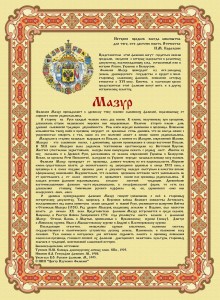 The collected data about family members will require official confirmation. If a woman got married several times, and accordingly the last names were different, this can be found out by sending a written request to the archives of the registry office. Ancient members may be found by last name in the church archives. You need to be prepared that you will have to pay for any request to the archive. Some certificates are issued free of charge, but this document, unfortunately, does not make it possible to find out everything about a relative. If a person was a military man, and you only know his first and last name, and you only have a photograph, don’t be upset. Ammunition, its shape can reveal missing details. You need to submit a search request to the military archive. The presence of awards narrows the search, because each order is taken into account in a specific journal, where it is indicated who it was awarded to and for what merits. And having learned which military unit he belongs to, you can send a further request to obtain more detailed information. According to the surname and other data, you can obtain information about rank, membership in a great family, or the result will show that the person is your namesake.
The collected data about family members will require official confirmation. If a woman got married several times, and accordingly the last names were different, this can be found out by sending a written request to the archives of the registry office. Ancient members may be found by last name in the church archives. You need to be prepared that you will have to pay for any request to the archive. Some certificates are issued free of charge, but this document, unfortunately, does not make it possible to find out everything about a relative. If a person was a military man, and you only know his first and last name, and you only have a photograph, don’t be upset. Ammunition, its shape can reveal missing details. You need to submit a search request to the military archive. The presence of awards narrows the search, because each order is taken into account in a specific journal, where it is indicated who it was awarded to and for what merits. And having learned which military unit he belongs to, you can send a further request to obtain more detailed information. According to the surname and other data, you can obtain information about rank, membership in a great family, or the result will show that the person is your namesake.
In addition to the registry office and military archives, there are huge repositories of census lists or arctic fox books (XV century).
Russian archives
To save time and money, it is very important to understand all departments. All archives are divided into divisions:
- Russian State Archive of Socio-Political History - includes data on workers, youth organizations
- Russian State Archive navy– documentation of the maritime ministry since 1827.
- Russian State Archive modern history– personal files of members of the Communist Party
- Russian State Military Archive - military data since 1920. Archive of the Red Army and Foreign Warfare of World War II
- Russian State Military Historical Archive - information from the pre-revolutionary period since 1797
- In the state archive, which stores data from the Soviet period and information of a pre-revolutionary nature
- Russian State Archive of Ancient Acts - documents from the archives: the imperial court from 1869 to 1920. State Archives - where information is stored from 1834 to 1920. An ancient repository of manuscripts from 1854 to 1882, an archive of old files - where information is stored from 1782 to 1852, an archive of patrimonial affairs, which stores data from 1768 to 1852
- Departmental archive - complete data about the working man of the Soviet period, labor awards, orders and personnel
 After documenting their belonging to a great family, everyone decides for themselves what to do with the certificates received. Some people file for an inheritance and, if circumstances turn out well, enjoy the benefits they receive. Others store data with a sense of inner pride and pass it on from generation to generation, like a family heirloom. All the time, supplementing my documentation so that descendants do not have to go through the difficult path of restoring the family tree.
After documenting their belonging to a great family, everyone decides for themselves what to do with the certificates received. Some people file for an inheritance and, if circumstances turn out well, enjoy the benefits they receive. Others store data with a sense of inner pride and pass it on from generation to generation, like a family heirloom. All the time, supplementing my documentation so that descendants do not have to go through the difficult path of restoring the family tree.
It often happens that the search process is not crowned with success; it’s just that the person who was considered a relative is a namesake. Some people get upset, but there are people who, having walked the path, are only inspired to create their own majestic surname.
After all, all great minds had people of a simple class in their family or were such themselves, for example Mikhail Lomonosov. This did not stop him from excelling in life and imprinting his surname in the history of mankind, which his descendants use and are proud of to this day.
In any case, a family tree is important information for everyone. Knowing who you are and where you come from, knowing your abilities and the availability of opportunities has always been valued in decent society. If it turns out that there is no one famous in the family, it doesn’t matter, because it is difficult, but already possible, to imagine how many people had to link their destinies for you to be born. It is most important.
In ancient beliefs, the spirits of ancestors were honored and considered patrons of the home, guardian angels. Now many people have difficulty remembering the names of their great-grandparents. Is this why they often talk about the disappearance of moral values and the loss of family feelings?
Why do you need to order genealogical search for ancestors?
A person’s first and last name contain secrets that leave a certain imprint on their bearer. What is his origin and class? What professions, position and social status did his ancestors have?
Surnames became widespread in the 18th century .
Their sources were work, nationality, character, faith, place of residence and much more. Knowledge about the family tree makes it possible to determine the circle of interests of the family, find movable and immovable property, or even treasures buried in difficult times.
Awareness is also good for health: knowing about predispositions to diseases makes it easier to prevent them.
However, finding such information on your own is an extremely difficult task. This requires paper research (which may mean a trip to another city), surveys, and the help of scientists. It is better to entrust an important matter to specialists - their search will be fast and accurate.
Stages of searching for family ties
Over time, the births intertwined and moved. Putting together the threads of this huge tapestry is a labor-intensive process consisting of several steps.
Genealogical examination
It is both the beginning of any search for ancestors and a separate service. The examination includes the formation of a family tree and a study of the safety of sources.
This initial sketch may include up to a dozen family lines related to the client's family.
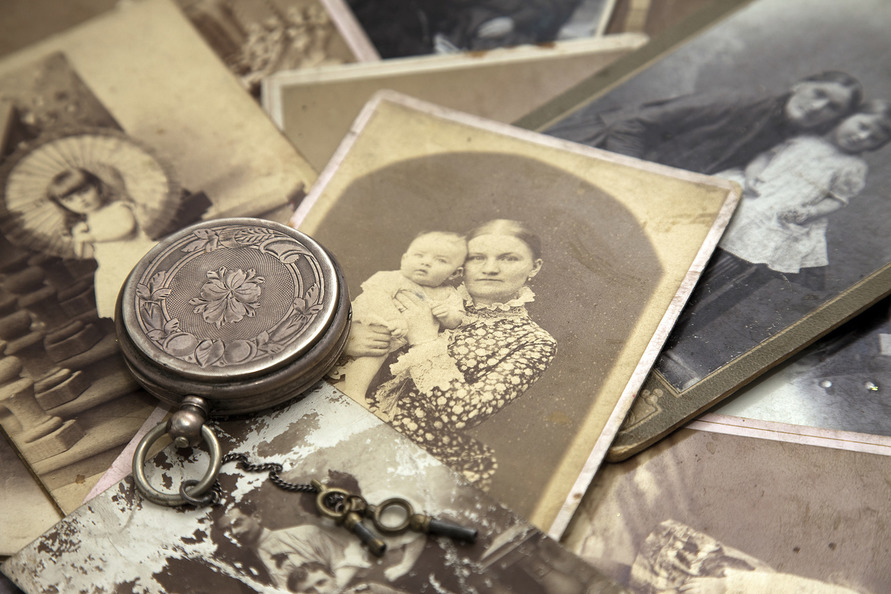 Objectives of the examination:
Objectives of the examination:
- Organize existing genealogical information. Collect information from relatives and find additions.
- Correct inaccuracies. Recover missing facts from available sources.
- Develop a prototype of a family tree.
- Understand the prospects of deep search and decide how further work will be carried out.
- Find out exactly where the information you need is stored.
- Create an algorithm and make a search estimate for the future.
After completing the first stage, the customer is left with a paper version of the family tree and printed archival photos.
Genealogical research and searching for ancestors in archives
Since the time of Peter I, population censuses began to be conducted and stored, which makes it possible to restore the genealogy until the beginning of the 18th century. And this is more than a dozen generations.
 Data on births, deaths and marriage registrations were recorded in parish registers in duplicate. The original was kept in the church, the duplicate in the archives of the consistory.
Data on births, deaths and marriage registrations were recorded in parish registers in duplicate. The original was kept in the church, the duplicate in the archives of the consistory.
In 1918, the “Code of Laws on Acts” was adopted civil status", metric notebooks were replaced with register ones. After one hundred years of storage by the civil registry office, they are redirected for eternal storage to the State Archives.
To search for ancestors by last name, experts delve into the wilds of various archives throughout the entire former Russian Empire.
The second part of the research is collecting family legends and working in local history museums. Told and recorded testimonies of descendants and contemporaries, hypotheses, legends, traditions - a huge layer of information.
can be divided into three types according to customer needs:
- "Full construction". All possible sources of information are used. Suitable for those who want to find ancestors up to the 12th generation and gain maximum knowledge about them.
- Classic. Working with several archives and indirect sources helps in revealing the history of a particular family, taking into account migration.
- Accurate. Search field - 1 regional or registry office archive, where the information necessary to confirm nationality or return relatives to their ethnic homeland is located.
How is DNA testing carried out and why is it needed?
Genetic research is a breakthrough in science that has made it possible to identify a genetic ancestor going back 150,000 years. Documents may be lost, but the information is written into a person's DNA.
 Studying it allows you to understand what part of the world a person’s roots lead to and what ethnic group he belongs to. The analysis also helps to find out the degree of relationship between people from the same family over several generations.
Studying it allows you to understand what part of the world a person’s roots lead to and what ethnic group he belongs to. The analysis also helps to find out the degree of relationship between people from the same family over several generations.
DNA tests are a magical journey into the depths of fifty generations of kinship. Moreover, the results are almost accurate. Lower down the tree, the reliability decreases, but the analysis shows what part of the Earth your ancestors came from, and what routes they took to settle in different territories.
Information will help you look at yourself and the world differently, because almost all people of the Caucasian race have up to one percent of Mongoloid genes. In addition, all people today carry about two percent of the genes of the Neanderthals, who disappeared forty thousand years ago.
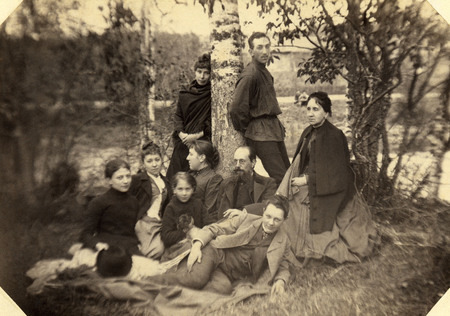 Hundreds of thousands of people around the world are interested in searching for their ancestors.
Hundreds of thousands of people around the world are interested in searching for their ancestors.
For those who have already been tested, a huge scientific database of the distribution of various genetic groups around the planet has been created.
By comparing your results with the available information, it is easy to find dozens, and sometimes hundreds of people who have a common ancestor with you. The test will clarify the degree of kinship and migration of the clan.
Options for using the information received
Any research is good if the result is clear. Having learned about his ancestry and family history, a person will want to preserve and pass on this information.
There are several options for its layout and design (or you can choose more than one - for example, keep something for yourself and give something to your family).
Drawing up and designing a family tree
There are a lot of possibilities here. The main thing is that you should like the design, because the tree will always be in front of your eyes at home or at work.
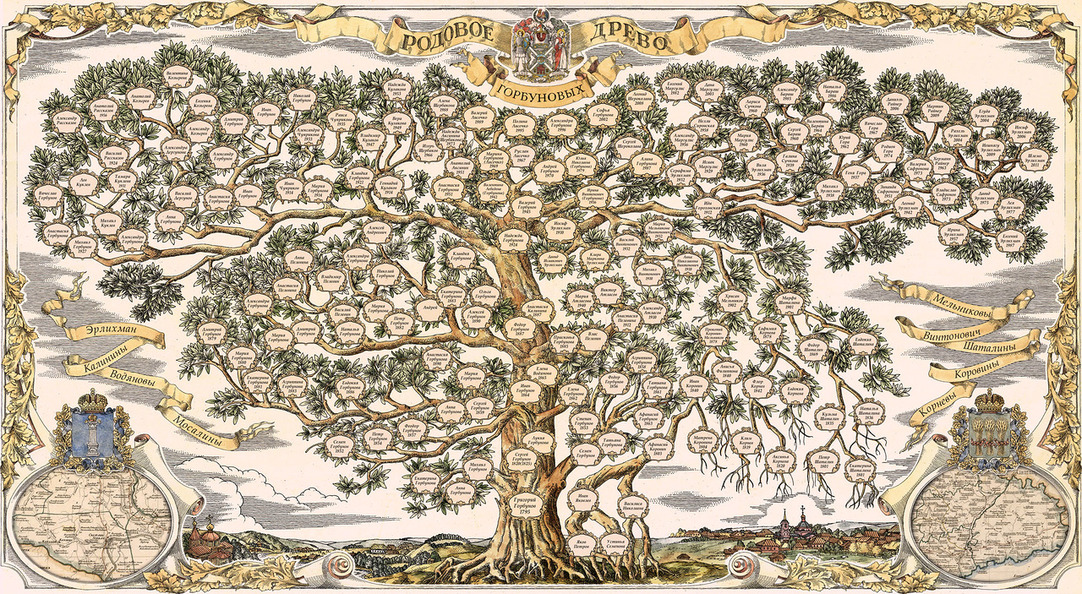 You can additionally illustrate it with parts of maps, insert pictures of landmarks or coats of arms of populated areas. The result will be:
You can additionally illustrate it with parts of maps, insert pictures of landmarks or coats of arms of populated areas. The result will be:
- Design tree diagram on photo paper or drywall. Information about all known relatives, systematized by a historian, turns into a tree with a unique design.
- Scenic tree. A professional illustrator creates a work in engraving techniques and watercolors. It is then transferred to canvas using high-quality plotter printing, maintaining a hand-crafted appearance.
- Carved solid wood panel. Made using 3D wood carving technique. The durable solid teak is oiled, which reliably protects the wood from damage. It contains icons with names made of aged brass. Lighting inside the frame creates a cozy atmosphere.
Writing a genealogy book
A magnificent gift for yourself and your descendants, which will be treasured by many future generations.
 The book can include all the collected information
- family tree diagram, results genealogical research, photos from the family archive, copies of documents, family traditions and legends. If desired, the publication includes a chronicle of memories of significant events in the history of the family from eyewitnesses.
The book can include all the collected information
- family tree diagram, results genealogical research, photos from the family archive, copies of documents, family traditions and legends. If desired, the publication includes a chronicle of memories of significant events in the history of the family from eyewitnesses.
You can decorate your family encyclopedia with a custom photo cover, calico or leather binding. Another option is the reconstruction of an antique publication from the 19th century.
What is the price search for ancestors and where to order it?
Specialists high level Houses of family traditions "Christian" will help restore family history, find ancestors by last name and lost relatives.
The research is carried out as quickly as possible, because specialists do not wait for answers from the archives of another city, but go to look for information themselves.
 Before starting an expensive in-depth study, an examination of the data is carried out. The customer learns the plan and cost of further research, and also receives copies of the collected documents, a schematic family tree, and a list of sources of information and materials.
Before starting an expensive in-depth study, an examination of the data is carried out. The customer learns the plan and cost of further research, and also receives copies of the collected documents, a schematic family tree, and a list of sources of information and materials.
Cost of genealogical examination- 95 thousand rubles.
Cost of genealogical research- depends on the time depth to which specialists must “get to the bottom”, and on the geography of the search, therefore it is negotiated individually with the manager.
As a result, you will have in your hands:
- family tree in the form of a diagram on photographic paper with a tube for storage;
- generational painting in the form of a brochure on designer paper;
- flash card with copies of found documents, a database and a tree in the “Tree of Life” program.
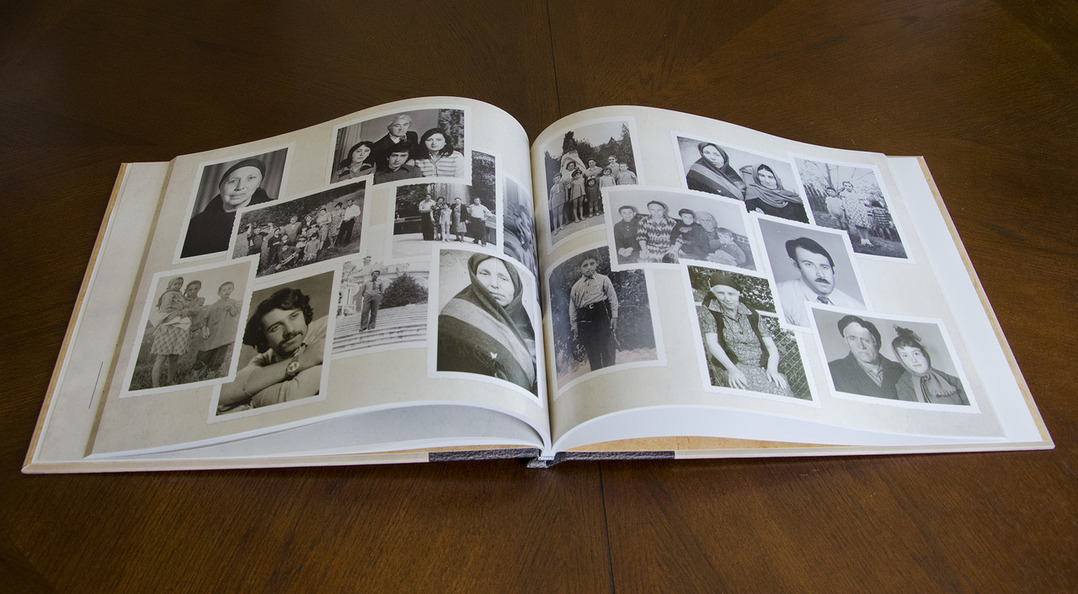 DNA test price- 85 thousand rubles. Test results are scientifically proven, accurate, and expressed as a percentage of probability. The analysis is faster than searching for ancestors by last name in the archives and does not depend on possible errors made in historical documents. All information is strictly confidential.
DNA test price- 85 thousand rubles. Test results are scientifically proven, accurate, and expressed as a percentage of probability. The analysis is faster than searching for ancestors by last name in the archives and does not depend on possible errors made in historical documents. All information is strictly confidential.
You can find out about the cost of other services by calling or writing to the managers of the House of Family Traditions.
A person can rethink himself after he finds out who our ancestors were. He realizes himself as an integral part on a huge tree of life, and can feel a connection with his own ancestors.
Each of us is a reflection of all the best that happened before him, a continuation characteristic features own kind.
Genealogical search ancestors in the archives is a set of activities aimed at studying the history of a family in order to establish the founders of the clan or collect details about the life of past generations. This article tells you how to search for ancestors on your own, but if necessary, you can order an archival search from our specialists in order to save the most valuable thing you have - time and nerves, because working in archives can be accompanied by difficulties that an inexperienced person it turns out, as a rule, not ready. Genealogical search for ancestors by last name- a labor-intensive process that requires knowledge of the rules of operation of state archives, local history museums and other institutions. Searching in the field of genealogy is a job that can be handled by a person who knows how to analyze large amounts of specific information.
When doing a genealogical search for ancestors, it is worth considering that in the process of researching archival documents, you may come across namesakes who have no family ties with your family, since the names in Russian Empire often invented in a banal way. For example, by place of residence, occupation or father's name. That is, the peasant Dmitry, the son of Ivan, became Ivanov (during the appearance of surnames among peasants), and since Ivan is one of the most popular names in XVII-XIX centuries- Now we have many families with this surname. And the search for the ancestors of the family takes on an almost detective character. Due to the nuances of archival work, conducting genealogical search for ancestors by last name, the task is not only to find the person, but also to prove that he is your relative. The actual connection between generations is determined by individual factors depending on the specific situation. A common method is to establish through a genealogical search in the archive that during the period of time under study, no people with the same name lived in the city, village or village whose mother and father were named accordingly.
To begin a genealogical search for ancestors in the archives, having sufficient initial information in hand, we recommend conducting family interviews to identify the oldest relative from whom research will be carried out into the depths of the family. You need to find out the date and place of birth of the person on whose line you plan to search for ancestors by last name. Collected materials Based on the results of a family survey, it can be used in family research, thereby significantly reducing the time spent working in state archives. The site administration also advises you to familiarize yourself with the main types of sources with which you will work in the archive and carry out a genealogical search by surname.
Genealogical search - archive documents used
There are more than 40 types of documents that became known to us when searching for ancestors in the archives. All of them can be classified as genealogical sources of information, but, unfortunately, detailed descriptions It is not possible to publish about each species in one material, so the article contains only the fundamental ones. From each archival source, conducting an effective genealogical search for ancestors by surname, you can glean important information, which will be useful in compiling a family (pedigree) tree and generational history of your family. This is what the list of main documents with data for drawing up a family genealogical table looks like:

1) Metric books (records of rituals);
2) Confessional paintings (for believers);
3) Revision tales (inventories of those living in the house);
4) Clergy lists (church ministers);
5) Population census (registration of the list of residents)
6) Formal lists (track records);
7) Rank books (appointments to service);
8) Scribe books (household inventories);
9) Recruit lists (those liable for military service);
10) Salary books (summary documents);
11) Chronicles (summary table).
Parish books contain information about the birth of children, marriages of the population, as well as information about the dead. By carrying out a genealogical search for ancestors in the archives, you can immediately track 3 events related to a representative of the clan. The register books are divided into settlements (in practice, there are both separate notebooks for the parish and combined volumes for the district, volost or county), and, as a rule, in the 2nd and 3rd blocks the age of the residents at the time of entry was indicated records, thanks to which it is possible to build a chain of family ties. For example, a place with the date of birth of a family member is known. It is necessary to contact the local state archive and request the metric book of the parish (the church to which the residents of the locality were “attached”) for the desired year or several years, if exact date not determined. Studying the part about those born, we look for a relative and, if we successfully search for an ancestor by last name and first name, we “fix” the parents. This information was entered into the corresponding column of the table; it is difficult to miss it. Then we find a mention of marriage in books for a certain period of time before the birth of the child and find out the age of the parents at the time of the wedding ceremony. Next, we “rewind” the indicated number of years (with an error of 1-3 years in both directions), trying to find the birth of the father and mother. We repeat the chain of actions, delving into older generations. This is just an approximate way to conduct a genealogical search for ancestors in the archives and the relationship of past generations of your family. For more detailed materials about the intricacies of the research process, the period of existence of metrics and other nuances, read the article on the website at the link above.

Confession books contain information about the confessions of residents, and from them you can obtain data about how believers your ancestors were, as well as how often a person attended church. Since the entries in the confessional statements were made after going around the courtyard, then, after analyzing these documents, it is also possible to determine the relationship of the older generations of the family. This knowledge should help to conduct a thorough genealogical search for ancestors, focusing on the most important, and not wasting precious time on secondary materials, studying archives.
Revision reports and population census are similar documents intended for compiling lists of taxpayers and total number residents of the administrative unit. It is most convenient to conduct genealogical research using these sources. search for ancestors by last name, since the records were grouped by house, and each house was inhabited by one or more peasant families. However, the fund of revisions has been preserved significantly worse than the same metric books, and therefore the researcher will be lucky if the archive provides a revision list of any locality for review. It is worth conducting a genealogical search using clergy records only if there is information that your ancestor was related to service in the church, since this type of document applies only to clergy.
Our family research bureau "Keepers of Family Secrets" recommends that you primarily pay attention to the first 5 types of genealogical sources, as they contain basic information for constructing a generational history of past generations of your family (if we are talking about studying the period of the 17th-20th centuries). Also, by searching the archives for ancestors using these documents, you can find out what class the family members belonged to, their profession, religion and some other important information from the point of view of knowing your roots. From the rest of the archival books you can get additional information about your last name, but to a much lesser extent. As can be seen in the picture attached to the article, sometimes documents are unreadable or difficult to understand due to poor preservation. In addition, genealogical searches for ancestors by surname are made difficult by the handwriting of the book fillers. Now these documents are in printed form and there is no need to recognize handwritten font, but in the 19th century and earlier everything was filled out only by hand. It would not be amiss to note that data about a person was entered from his words, so with enviable regularity there are discrepancies in dates of 1-3 years, and if you want to make every effort to study your pedigree history, then always take into account an error of several years and then search for ancestors will be successful.
Searching for ancestors in archives using genealogy - rules of work
If you were quick to think that these are all the difficulties that can be encountered during a genealogical search for ancestors, then this is a mistake. An additional complication is the fact that the territorial division of modern Russian Federation has changed frequently throughout its history. In practice, when searching, this is reflected in the following way: in the 19th century, the village belonged to one county and historical documents on it are stored in the corresponding regional state archive, and for the 18th century, the documents are already in another city, since during the specified period the settlement was tied to another region. It happens when doing genealogical research family research by surname and when searching for your ancestors, you have to seek help from the head of the reading room in order to determine the affiliation of the city. Consider yourself very lucky if an experienced archive employee suggests a solution to this problem. Otherwise, it may take several days just to study the history of the region and the reassignment of the administrative unit.

Warning you against single trips, we warn you that the statutes of certain types of archives, for example, military archives for documents from the Soviet period or civil registry departments, and federal laws limit the conduct of genealogical searches for family ancestors. Keep in mind that family research in this case is only possible if the relationship with the person you are looking for is confirmed. If the surname Ivanov is indicated in the passport (figuratively), then you can only search for the Ivanovs. If you need to search for ancestors by your wife's last name, you must have a copy of the marriage certificate with you, where her maiden name will match the name on the birth or death certificate of the person you want to find. Building a chain of family ties is not as simple as it might seem, and institutions take this very seriously, because by allowing a person to access genealogical sources, archives allow him to study people’s personal data. Searching in military archives (departmental), as well as specialized institutions, by the way, has the most stringent restrictions. At the end of the tutorial, we’ll tell you how to search in archives by last name, if there is no proof of relationship.
If it is not possible to confirm your relationship upon admission to the archive, then you have two legal options. The first is to obtain a power of attorney from the person whose surname will be used to conduct a genealogical search for ancestors. The second is to become a writer or journalist and indicate in the application for the reading room that you are writing the history of the region or reporting about the city. Be prepared that at the entrance you will be asked to present identification from an official organization. Of course, in one article it is impossible to explain and mention all the intricacies of a genealogical search by surname, since there are private rules for specific archives, such as the ban on photography with flash, leafing through books with ancestors only with rubber gloves, and more. But the Livemem administration hopes that, at least a little, it has made the path easier for you to research your family history. Luck with searching!
If you have any additions, please let us know in the comments and we’ll make a useful resource together!
All rights reserved, text copying is permitted only with a link to the site.
Today, due to various circumstances, many are looking for missing relatives and friends, information about relatives and friends, grandfathers and great-grandfathers, and finding out their roots. Various services can come to help in solving these problems, such as:
Large genealogy sites:
- - a constantly growing online collection of information about people associated with Russia, regardless of nationality and time of life. With the help of IOP, people can find lost relatives, friends and acquaintances, and create clubs of namesakes. The site also provides tips for beginners ( the first step, communication, terms of kinship, class and other population groups; how to systematize information and build family trees; what you can find out in the registry office; what can be found in departmental archives; working with books and the Internet; Is it possible to find out your ancestry by last name; searching for relatives abroad and more).
- Russian family tree (RGD)— information on genealogy, clans and clans. The site contains information on families and clans, an index of surnames, genealogical research, links on genealogy to site forums divided by region, goods and services (ordering family diplomas) and RGD forums;
- Genealogy.ru— commercial project: professional design of family trees, information on genealogy; you can download the “Genealogy” program (registration for up to 30 people is free).
If you need to find lost relatives, you can seek help from national mutual search service(site of the program “Wait for me”).
To search for relatives, you can contact the Main Information and Analytical Center of the Ministry of Internal Affairs of Russia:
- forum.mvd.ru— forum;
Search and search for soldiers:
- obd-memorial.ru— a project of the Russian Ministry of Defense to systematize records and documents about fallen soldiers in World War II and subsequent conflicts;
- trizna.ru mdash; regional youth organization search association "Trizna" to search for missing soldiers (available forum);
- soldat.ru- search and search for soldiers (there is forum).
You can also search for people:
- search.goon.ru— search for people, relatives, classmates.
Family tree and search for relatives and friends
Today there are on-line services to create family trees, where you can create your family tree on the Internet and find people:
- familyspace.ru— family social network; searching for people, names and relatives, creating a family tree;
- myheritage.com- one of the world's largest family networks, where you can create your family tree, find people and ancestors, create your own family website for family meetings on the Internet;
- mykin.ru— service for creating family trees;
- genway.ru— on the site you can create a family tree, search for people, relatives, namesakes;
- rodoslovnik.ru— drawing up a family tree, family tree, searching for relatives, distant and close.
semiyaonline.ru— on the service you can build your own family tree and find relatives registered on the site and invite them to join the common family tree. Registration required. The service has 10 million users (as of September 2009);
The site " Archives of Russia", containing information on federal and regional archives (characteristics of funds, lists of services, contact information, etc.). Information about editions and publications, databases, archival projects, etc.:
- rusarchives.ru— archives of Russia. The official website of the Federal Archive Agency (Rosarkhiv) and the industry-wide archival portal.
Programs for compiling a family tree
- genery.com/en- website of one of best programs for building family trees "Tree of Life". The program is free when compiling a family tree for up to 40 people.
- genopro.com — GenoPro. One of the world's most popular genealogy programs, used by genealogists, doctors, social workers, teachers, and researchers in these fields. A version for free testing is available on this official website.
- Family Tree Builder- one of the best programs for creating a family tree from a family social network myheritage.com (the program can be downloaded for free).
- GRAMPS- free project software(free) for genealogy, offering a professional genealogy program and wiki open to everyone. This is a hobby project created, developed and managed by genealogists. The program will help you track your family tree, providing the ability to store, edit and research genealogical data.
You can find out the origin of your surname and your ancestry if you know how to do it. Read the information in the article about where you can go and on what sites you can look up your family history.
Nowadays, many people want to know their ancestry and where its roots come from. However, knowledge is usually limited to information about great-grandparents.
- Nowadays it is popular to draw your family tree.
- In addition, many people are confident that those who honor and remember their ancestors will live a healthy and long life.
- For religious reasons, you need to know the sins of your distant relatives and be able to repent for them in order to improve your life.
- It is also important to know the genetics of the family and predisposition to certain diseases.
- From this article you will learn information about how you can independently find out the history of your family, where the database is located, and whether this can be done for free, for example, on the Internet.
As it says folk wisdom: “The most important thing is to start.” If there is a beginning, clues will appear and you will be able to look deep into the history of your family. So, where to start your search in order to independently find out the pedigree, the family tree of your family by last name? Instructions:
- Collect all papers and documents from your grandparents, which they inherited from their relatives, parents or even grandmothers. Make an inventory of these papers: list, description and summary. Do not restore old documents and photographs, just make photocopies.
- Conversations with relatives. Ask grandparents, parents, aunts and uncles about what they remember about their family. If relatives live in other cities, send your questions in a letter. Always walk with a notepad and pen, because perhaps you will meet some distant relative on the street, and in order not to ask for a visit, you can ask him about everything and write it down. Ask about everything: who they worked for, where they served, what their hobbies were, traditions, whether there are any special jokes in the family or words that other people do not understand.
- Dictionary of surnames, which is available in any large library, will help you find out about the geographic area where the surname appeared. This will help a lot as you will know where to move next.
- Examine the family aspects associated with participation in wars.“The Book of Memory” is a complete collection of names of people who went through the war, went missing or died during hostilities. This book is available in libraries, museums and even on the Internet at this link.
- Archive search. Once you have found out which area your ancestors lived in, look for archival data for that area. You can order a paid certificate from the archive on documents of interest.
Remember: All people remember the same event differently. They may give different dates of birth, confuse classes and localities. They may also not remember the names of other people's children. But the picture will still gradually emerge, ready for subsequent research.

The search for roots by surname is now being actively carried out by historians. Various dictionaries, online resources and reference books help you conduct your research. There are several ways to search for ancestors and relatives by your father’s last name:
- Surname directories, which are located in the reading room of each library, will help you find out the meaning of the surname. Previously, surnames came from the father's professional occupation - this would be your distant relative. For example, the surname Bondarev is the son of a cooper. The princes had surnames similar to the names of the lands - Vyazemsky, Shumsky. The surname could come from the clergyman who ruled the church in a particular city or from the location of the area where the person lived.
- Contacting the State Center for Genealogical Research. This center has its own website at this link. Here you can find information about your roots, which go back to pre-revolutionary times. The database is constantly updated.
- Search the archives. You need to know minimal information about your ancestors: where they lived, what they did.
- Search on the Internet. The FamilySpace website contains unique information about genealogy. The search is carried out by profession, region of residence, last name.
- Search through TV shows. Program website " Wait for me" can be found at this link. See if someone is looking for you or apply to find a relative.
Advice: Look for ancestors while grandparents are alive. The history of the family should remain for posterity, let them know their ancestors. As people say: “The soul is alive as long as it is remembered.” Leave a photo, and after time, your descendants will know and remember you.

There are archives in every city and even village. To find information about relatives in the archive, you must first trace the biographies of your relatives, at least minimal data - in which area they lived, where they worked. Once you know the ancestor's area of residence, you can contact the archives of that area with a request.
Advice: Make a paid request, for example, through a notary, then the search will be faster and more effective.
 TV show “Wait for me” - search for people: database
TV show “Wait for me” - search for people: database It is much easier to look for a person if experienced and professional historians and genealogists help with this. In the television project “Wait for me,” people are searched using different databases. The specialists of this TV show are performing what would seem to be the most hopeless search. But people are found, they meet, and a new genealogy is written.
As mentioned above, this project has its own website where you can put a person on the wanted list by last name, first name and age. To find information about a person, you must first register on the site. Then click " Search» and fill out the form.
 TV program “Wait for me”
TV program “Wait for me” If any search data appears, you will be notified about it via the specified contacts. By searching for people, several million people were found on this TV show. More than 5,000 volunteers are helping to search. Therefore, if you seek help with this project, be sure to find the necessary information.
When applying to a TV show, you will have to wait some time for the information to appear if it is not in the project database. But I want to search instantly, enter the last name and find the right person. The FamilySpace website does this kind of search for people on the Internet by last name for free. Instructions on how to use the search on this resource:
Go to the main page of the site using this link. Click " Register" Go through the entire procedure from start to finish.

Then click the " To start searching».

You can also search from your page. There is a window at the top where you need to enter your last name to search. Enter the name of the person you are looking for and the site will instantly display results. All you have to do is look through the profiles of people with the same last name and first name and find the one you were looking for.

If such a search does not produce the desired results, try searching in the archives. Follow this link and you will see archives of past centuries, state archives and directories of cities and regions.

This site has great search capabilities. There are over 6 million registered users and it is possible most of people have already found their ancestors or distant relatives.
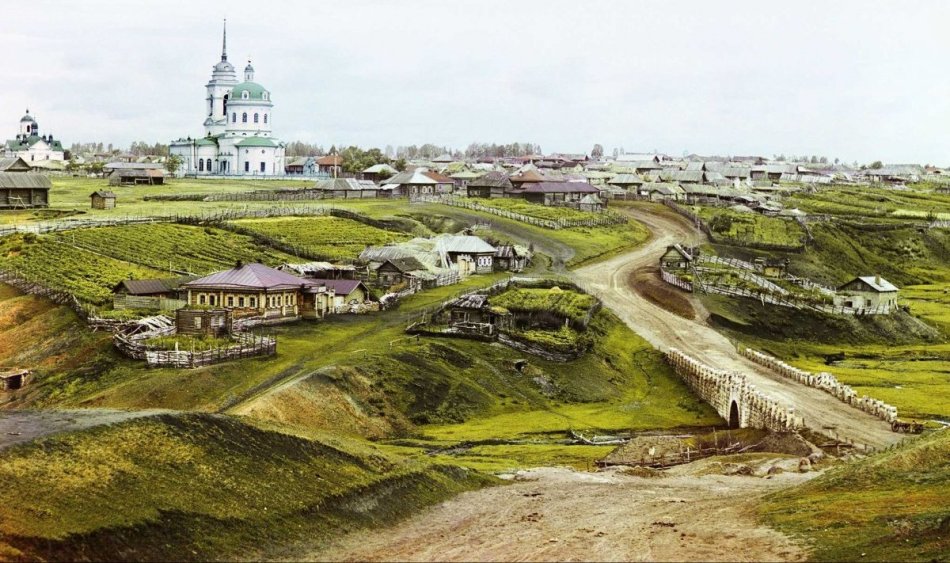
Start the search forgotten villages will help you find the roots of your parents and grandparents. Previously, villages were called provinces, then they were renamed before the war and again given new names after the war.
- Therefore, many people reach a dead end when searching for a pedigree, especially if the question concerns the geography of the surname.
- How to find the history of a village? Historians and geneologists have long been talking about the need to return old names to villages and hamlets. This will help make searching for the roots of the genus easier and faster.
- Currently, you can find old villages in stationary and electronic libraries.
- There is also a publication " Lists of villages of the Russian Empire", which published the names and locations of the provinces of that time. Thanks to this publication, you can find what any modern village was called before.
Important: When searching, keep in mind that the boundaries of provinces have changed, and therefore many villages will have to be searched in neighboring regions.
There is a website on the Internet that contains a catalog of populated areas of the Russian Empire. It is located at this address. In the " All lists» you will find a list of Russian provinces in alphabetical order.
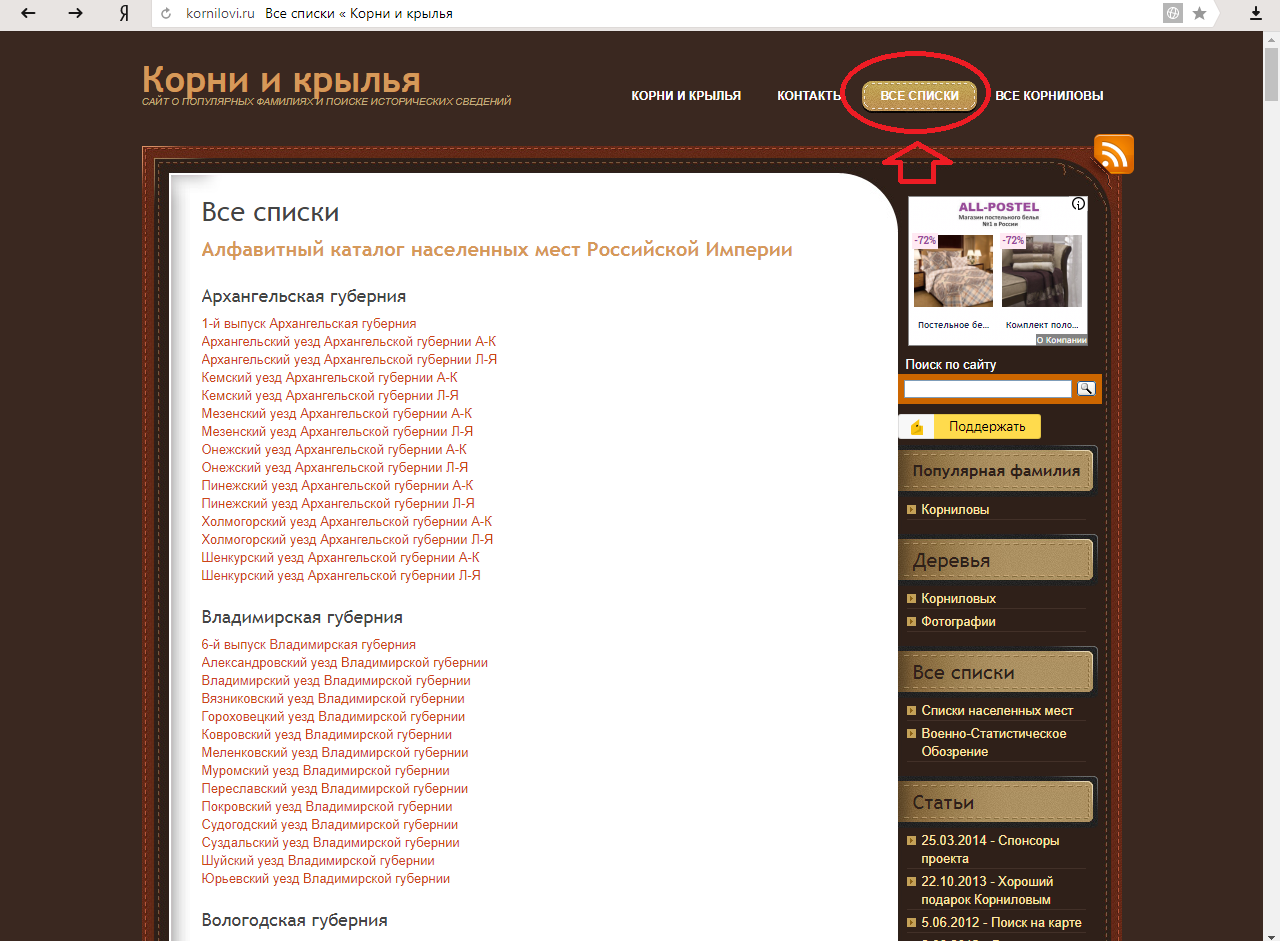
Whatever method you choose to search for your ancestors, any of them will provide good results. Your descendants will be grateful for the search for such information, because with each generation it becomes more and more difficult to find information about any distant ancestor.



















